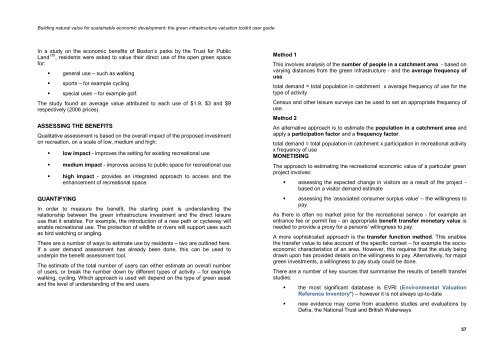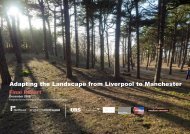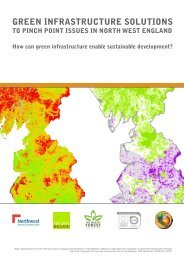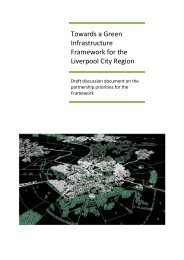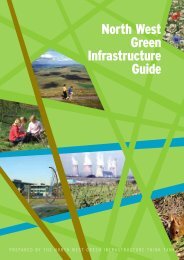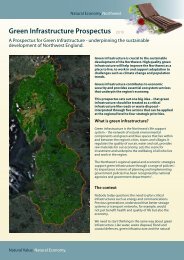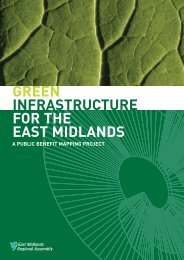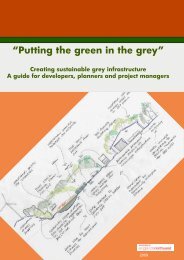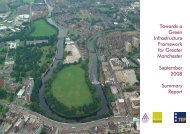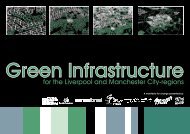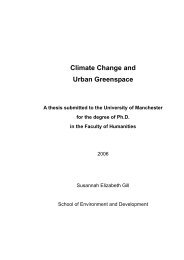The green infrastructure valuation toolkit user guide
The green infrastructure valuation toolkit user guide
The green infrastructure valuation toolkit user guide
Create successful ePaper yourself
Turn your PDF publications into a flip-book with our unique Google optimized e-Paper software.
Building natural value for sustainable economic development: the <strong>green</strong> <strong>infrastructure</strong> <strong>valuation</strong> <strong>toolkit</strong> <strong>user</strong> <strong>guide</strong><br />
In a study on the economic benefits of Boston’s parks by the Trust for Public<br />
Land 135 , residents were asked to value their direct use of the open <strong>green</strong> space<br />
for:<br />
<br />
<br />
<br />
general use – such as walking<br />
sports – for example cycling<br />
special uses – for example golf.<br />
<strong>The</strong> study found an average value attributed to each use of $1.9, $3 and $9<br />
respectively (2006 prices).<br />
ASSESSING THE BENEFITS<br />
Qualitative assessment is based on the overall impact of the proposed investment<br />
on recreation, on a scale of low, medium and high:<br />
<br />
<br />
<br />
QUANTIFYING<br />
low impact - improves the setting for existing recreational use<br />
medium impact - improves access to public space for recreational use<br />
high impact - provides an integrated approach to access and the<br />
enhancement of recreational space.<br />
In order to measure the benefit, the starting point is understanding the<br />
relationship between the <strong>green</strong> <strong>infrastructure</strong> investment and the direct leisure<br />
use that it enables. For example, the introduction of a new path or cycleway will<br />
enable recreational use. <strong>The</strong> protection of wildlife or rivers will support uses such<br />
as bird watching or angling.<br />
<strong>The</strong>re are a number of ways to estimate use by residents – two are outlined here.<br />
If a <strong>user</strong> demand assessment has already been done, this can be used to<br />
underpin the benefit assessment tool.<br />
<strong>The</strong> estimate of the total number of <strong>user</strong>s can either estimate an overall number<br />
of <strong>user</strong>s, or break the number down by different types of activity – for example<br />
walking, cycling. Which approach is used will depend on the type of <strong>green</strong> asset<br />
and the level of understanding of the end <strong>user</strong>s.<br />
Method 1<br />
This involves analysis of the number of people in a catchment area - based on<br />
varying distances from the <strong>green</strong> <strong>infrastructure</strong> - and the average frequency of<br />
use.<br />
total demand = total population in catchment x average frequency of use for the<br />
type of activity<br />
Census and other leisure surveys can be used to set an appropriate frequency of<br />
use.<br />
Method 2<br />
An alternative approach is to estimate the population in a catchment area and<br />
apply a participation factor and a frequency factor.<br />
total demand = total population in catchment x participation in recreational activity<br />
x frequency of use<br />
MONETISING<br />
<strong>The</strong> approach to estimating the recreational economic value of a particular <strong>green</strong><br />
project involves:<br />
assessing the expected change in visitors as a result of the project -<br />
based on a visitor demand estimate<br />
<br />
assessing the ‘associated consumer surplus value’ – the willingness to<br />
pay.<br />
As there is often no market price for the recreational service - for example an<br />
entrance fee or permit fee - an appropriate benefit transfer monetary value is<br />
needed to provide a proxy for a persons’ willingness to pay.<br />
A more sophisticated approach is the transfer function method. This enables<br />
the transfer value to take account of the specific context – for example the socioeconomic<br />
characteristics of an area. However, this requires that the study being<br />
drawn upon has provided details on the willingness to pay. Alternatively, for major<br />
<strong>green</strong> investments, a willingness to pay study could be done.<br />
<strong>The</strong>re are a number of key sources that summarise the results of benefit transfer<br />
studies:<br />
<br />
<br />
the most significant database is EVRI (Environmental Valuation<br />
Reference Inventory*) – however it is not always up-to-date<br />
new evidence may come from academic studies and e<strong>valuation</strong>s by<br />
Defra, the National Trust and British Waterways<br />
57


